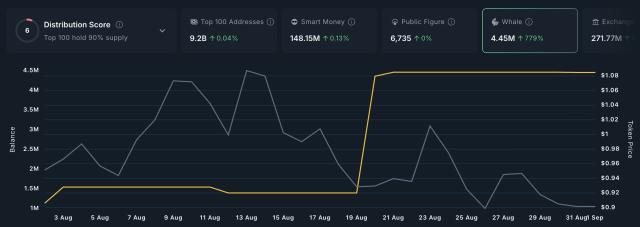Bitcoin 's "red month" has officially arrived. Is a price drop inevitable? Let's take a look at some of the reasons why September has historically been a poor month for Bitcoin. Dynamic Zone Supplement: Bitcoin dipped to $107,500 at 6:00 a.m. today (2), before rebounding to $109,000 before press time.
September is typically a poor month for Bitcoin
September has been a challenging month for Bitcoin since 2013, with prices declining in eight of the past 11 years. This may be because retail investors often take profits after the summer rally, even selling cryptocurrencies to cover fall expenses like tuition and tax planning.
Bitcoin's "Red September" could also be a self-fulfilling prophecy. As traders generally anticipate a price drop, they adopt more conservative, defensive strategies, pushing the market further downward. However, objectively speaking, most September pullbacks are relatively mild.

It's worth noting that September typically forms a "local bottom," after which Bitcoin often rebounds strongly into a "Golden October." Historically, the fourth quarter often sees market recoveries, or even significant increases. For example, in October 2020, Bitcoin soared from approximately $10,800 at the beginning of the month to over $13,800 by the end of the month, a gain of over 27%.
Bitcoin falls after reaching new high
No matter how you look at it, August 2025 was a dramatic month. On August 14, Bitcoin hit an all-time high of $124,533, but just two weeks later it plummeted 11% to a low of around $110,000.
The drop wiped out nearly $200 billion in market capitalization, and one possible trigger was a long-dormant whale that dumped about 24,000 BTC, pushing the spot price below $109,000 and triggering the largest liquidation chain reaction of the year.
Nearly $900 million in derivatives positions were forcibly liquidated during this period, 90% of which were bullish long positions. Bitcoin alone saw $150 million in liquidations, while Ethereum saw $320 million in liquidations. In comparison, Ethereum has shown relative resilience: even after an 8% drop, it remained above its 100-day moving average.
The recent market weakness isn’t just a matter of technicals or sentiment. Order books in both spot and derivatives markets remain thin, so any large-scale sell-off (such as the whale sell-off mentioned above) is enough to amplify price fluctuations.
At the same time, on-chain data at the end of August showed sluggish market activity and reduced capital inflows, further weakening buying support.
Keep a close eye on the Federal Reserve
Macroeconomic uncertainty also continues to pose a headwind. As the market focuses on the US Federal Reserve's policy moves in September, traders are assessing the risk of market volatility and hoping that positive macroeconomic signals (such as interest rate cuts) will rekindle market optimism.
Cryptocurrency trader Cas Abbé proposed three possible scenarios for Bitcoin's market as September approaches.
* "Ranging and Correcting" scenario (40% probability): Bitcoin is expected to trade sideways between $110,000 and $120,000 for most of September. During this period, the market will gradually reduce excess leverage and institutional investors will gradually enter the market to increase their holdings. This consolidation will lay a healthier foundation for a potential fourth-quarter rally.
* "Double Dip" Scenario (35% probability): If Bitcoin falls below $110,000, it could trigger a wave of liquidations, pushing the price down to the high $100,000s and wiping out remaining leveraged positions. Historically, such pullbacks have often preceded a "strong bottom."
* "Quick Recovery" scenario (25% probability): If institutional investors buy heavily, Bitcoin may quickly reclaim the $117,000-118,000 range, igniting bullish sentiment in advance.
Abbé suggested that traders should pay close attention to multiple chain and macro signals throughout September, especially the activity in the options market before the expiration of options on September 27, which may provide important clues for judging the market position structure and sentiment.
Whether Bitcoin's "red month" of September this year will turn into a "green month" remains to be seen. However, given the current thin liquidity, increased volatility, and institutional buyers waiting for an opportunity to enter the market, September this year may hold both risks and opportunities.









